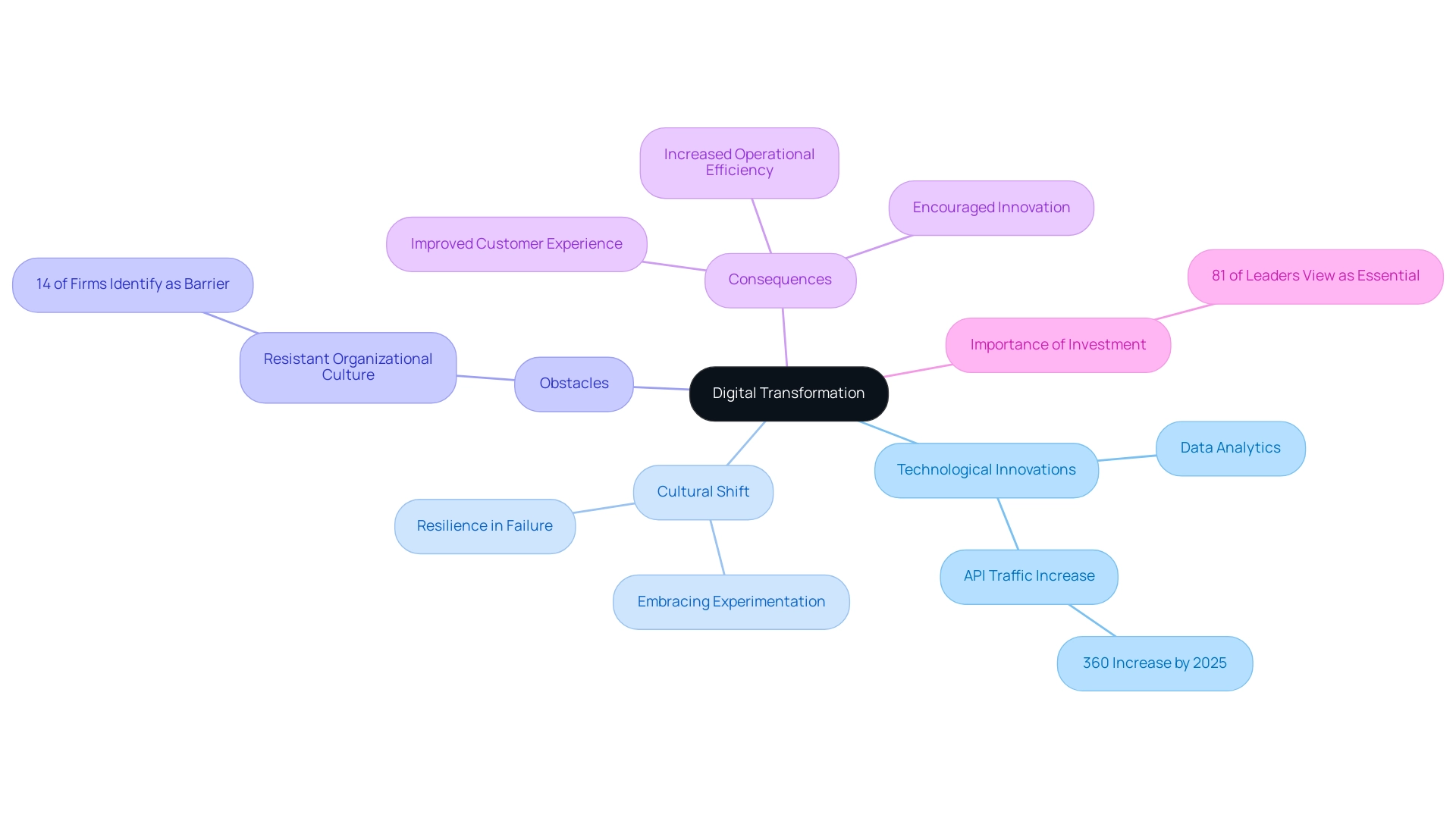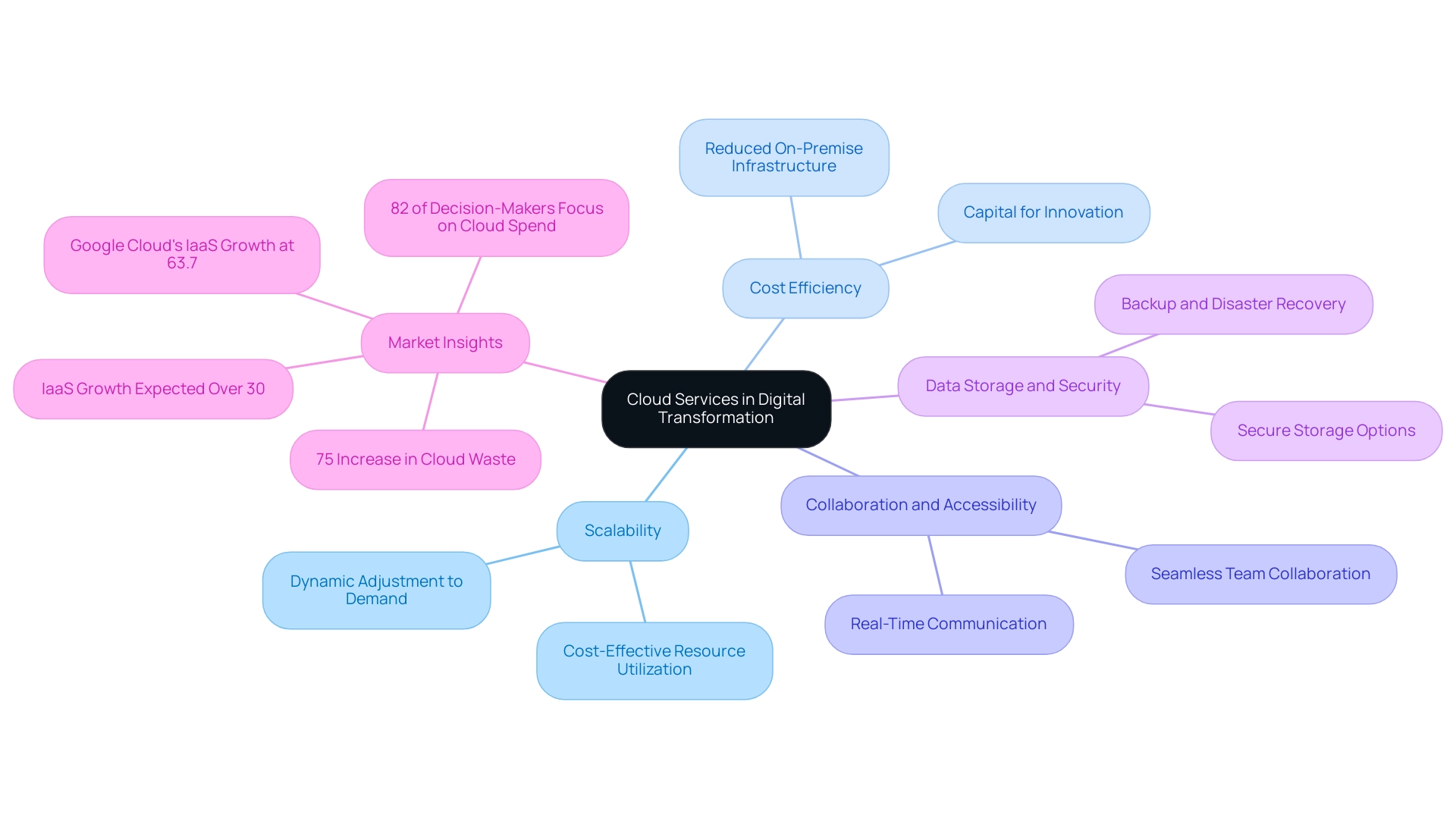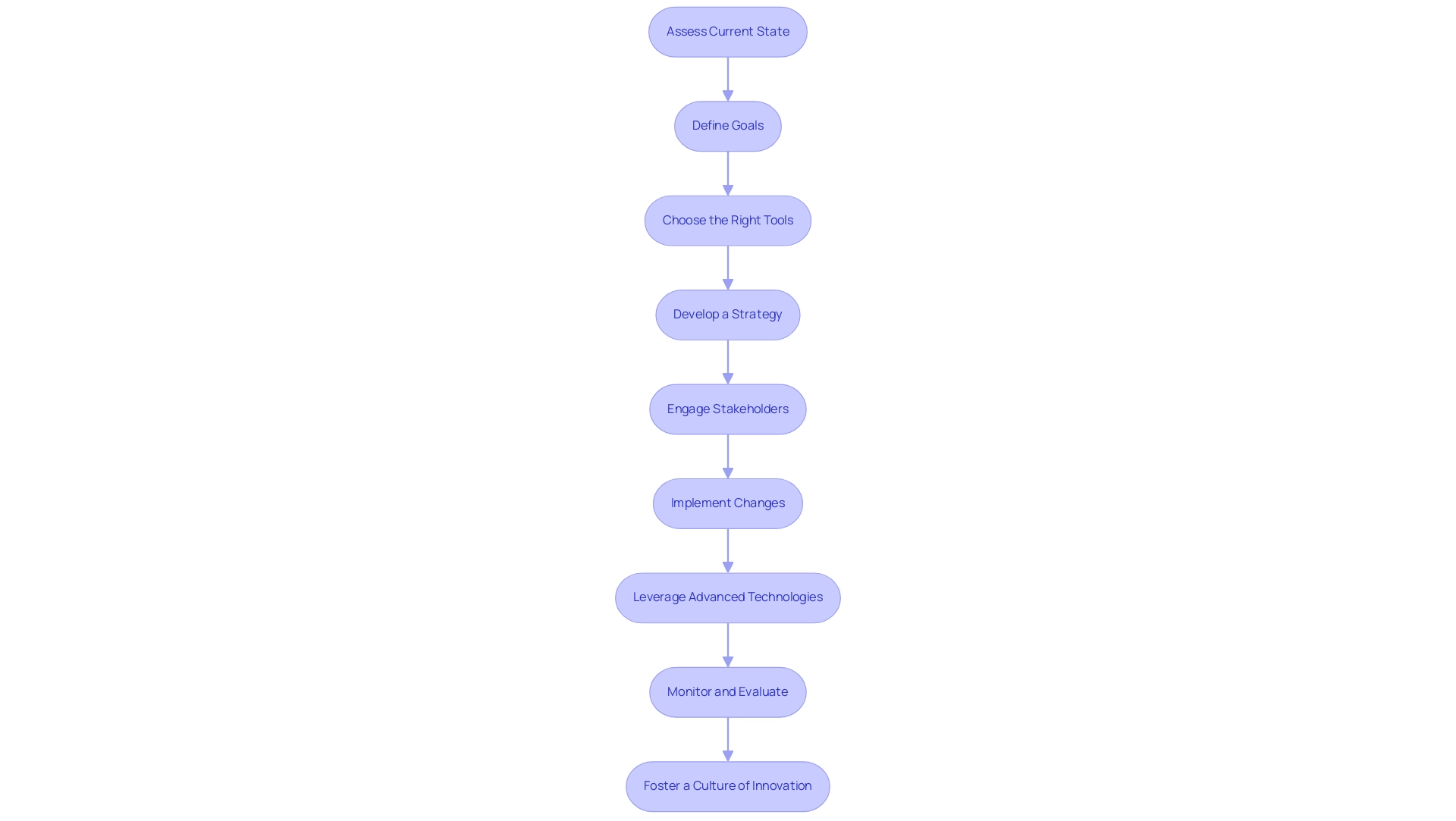Introduction
In today's rapidly evolving business landscape, digital transformation has become a critical imperative for organizations striving to maintain competitiveness and relevance. This multifaceted process goes beyond simply adopting new technologies; it necessitates a fundamental cultural shift that fosters innovation, adaptability, and resilience.
With a staggering increase in digital interactions and data-driven decision-making, businesses must not only embrace these changes but also strategically leverage various platforms and tools to enhance operational efficiency and customer engagement.
From harnessing cloud services to implementing tailored e-commerce solutions, understanding the nuances of digital transformation is essential for navigating the complexities of modern commerce.
This article delves into the key components of successful digital transformation, offering a comprehensive guide that equips organizations with the insights needed to thrive in an increasingly digital marketplace.
Understanding Digital Transformation: A Business Imperative
The shift to technology involves the thorough incorporation of technological innovations throughout all aspects of an organization, fundamentally altering operations and the provision of value to clients. It transcends mere technological upgrades, requiring a significant cultural shift within organizations. This shift compels organizations to challenge existing norms, embrace experimentation, and develop resilience in the face of failure.
Significantly, 14% of firms recognize a resistant organizational culture as an obstacle to this change, emphasizing the risks of stagnation in an increasingly technological marketplace. As the Mulesoft Connectivity Benchmark Report reveals, a staggering 360% increase in API traffic is projected by 2025, underscoring the urgent need for organizations to harness data analytics and innovative technologies to remain competitive. In fact, 81% of business leaders claim that investments in technological change are essential for achieving success.
The consequences of technological change are significant: organizations can improve customer experiences, increase operational efficiency, and encourage innovation through streamlined processes and task automation. For instance, technological advancements are streamlining processes and automating tasks, which enhances productivity and saves time and money for organizations. Conversely, companies that resist this evolution risk losing market share and relevance in their industries.
By adopting technological innovation, companies place themselves not only to address shifting consumer habits but also to succeed in a swiftly changing market.

Exploring Digital Transformation Platforms and Tools
The landscape of digital transformation and cloud services is continuously evolving, with a plethora of platforms and tools designed to enhance operational functions in 2024. Our tailored e-commerce solutions have a proven track record of significantly improving critical KPIs for our clients, enhancing retention rates, boosting Average Order Value (AOV), and increasing Lifetime Value (LTV). These solutions are specifically designed to build incremental revenue by optimizing user engagement and streamlining purchasing processes.
Here are several key categories and representative examples:
-
Client Relationship Management (CRM): Leading solutions like Salesforce and HubSpot empower businesses to manage client interactions effectively, streamline workflows, and significantly enhance service. Significantly, research from Salesforce indicates that 71% of individuals are more likely to trust a company with their personal data if its usage is transparently communicated.
This highlights the significance of CRM tools in establishing client trust and addressing concerns about data privacy. -
Project Management: Tools such as Asana and Trello facilitate team collaboration, task management, and project tracking, ensuring that projects stay on schedule and within budget. These platforms have been demonstrated to enhance team productivity and cohesion, which are essential in today’s fast-paced corporate environment.
-
Data Analytics: Advanced tools like Google Analytics and Tableau provide profound insights into consumer behavior and overall organizational performance. Such data-driven decision-making is essential for tailoring strategies to meet evolving market demands.
-
E-commerce Solutions: Platforms like Shopify and WooCommerce are instrumental in establishing and optimizing online sales channels.
Our custom solutions, developed over 20 years of unparalleled experience, are designed to create products that your community will love, directly mapping to your internal goals and KPIs. By implementing these customized e-commerce solutions, companies can significantly boost their revenue streams through improved client experiences and targeted marketing strategies. -
Collaboration Tools: Applications like Slack and Microsoft Teams improve communication and teamwork among remote groups, cultivating a connected workforce irrespective of physical location.
Nevertheless, organizations encounter considerable obstacles in adopting these technological tools, with 22% of IT leaders indicating economic uncertainty as a key challenge. By strategically leveraging these tailored solutions, organizations can not only overcome such challenges but also significantly boost efficiency, elevate customer experiences, and drive innovation through digital transformation and cloud services. The incorporation of technology customized for employee requirements, as demonstrated in the case study titled 'Leveraging Advanced Technologies,' indicates that utilizing electronic tools to enhance information accessibility more than doubles the chances of a successful change, resulting in greater satisfaction and profitability.

The Role of Cloud Services in Digital Transformation
Cloud services are crucial for advancing technological change, as they support digital transformation and cloud services, providing companies with the adaptability, scalability, and cost-effectiveness necessary for responding to shifting market dynamics. The key benefits of adopting cloud solutions include:
- Scalability: Cloud services enable organizations to dynamically adjust their operations in response to fluctuating demand, ensuring that they only incur costs for the resources they actually utilize. This model is crucial in today's fast-paced environment where market conditions can change rapidly.
- Cost Efficiency: Leveraging cloud technology enables organizations to minimize their reliance on extensive on-premise infrastructure, which significantly lowers operational costs. This transition can free up capital for innovation and growth.
- Collaboration and Accessibility: Cloud-based applications facilitate seamless collaboration among teams, allowing for real-time communication and cooperation, regardless of geographical barriers. This boosts productivity and nurtures a more flexible organizational culture.
- Data Storage and Security: Cloud services provide strong and secure storage options for sensitive information, enhanced by thorough backup and disaster recovery alternatives, which are essential to ensuring operational continuity.
As organizations acknowledge that 82% of cloud decision-makers prioritize overseeing cloud expenses, and with 75% of organizations indicating a rise in cloud waste, the integration of digital transformation and cloud services into your technological advancement strategy becomes crucial. Furthermore, the cloud services market is poised for significant growth in 2024, with IaaS expected to lead this expansion at over 30%. Notably, as Cody Slingerland highlights, 'Combined, these two regions account for 82% of the world’s cloud computing.'
Additionally, Google Cloud's IaaS offering has already experienced remarkable growth of 63.7%, solidifying its position as a formidable player in this space, as demonstrated in the recent case study on Google Cloud's IaaS growth. By incorporating digital transformation and cloud services, businesses can enhance their capacity for innovation and responsiveness, ensuring they remain competitive in a rapidly changing landscape.

A Step-by-Step Guide to Implementing Digital Transformation
Executing technological change can be a complicated procedure, yet an organized method can simplify your path to achievement. Research indicates that 17% of IT projects fail so severely that they pose a risk to company survival, underscoring the critical need for careful planning in light of challenges such as competing priorities and skill gaps. Here’s a step-by-step guide to help you navigate this change:
- Assess Current State: Begin by evaluating your existing operations, technologies, and processes. This assessment will help identify areas ripe for improvement, laying the groundwork for effective change.
- Define Goals: Establish clear, measurable objectives for your online initiatives. Whether your focus is on enhancing customer engagement or boosting operational efficiency, having defined goals is crucial for tracking progress.
- Choose the Right Tools: Select suitable online platforms and tools that align with your business requirements. This choice should be informed by your defined goals, ensuring that the tools facilitate desired outcomes.
- Develop a Strategy: Formulate a thorough plan for technological change that delineates the required steps, resources, and timelines. This strategic framework will guide your efforts and help allocate resources efficiently.
- Engage Stakeholders: Involve key stakeholders from various departments early in the process. According to Veeam, 22% of IT leaders mention economic uncertainty as a significant challenge to implementing technological changes. Understanding how this uncertainty can hinder progress is vital; therefore, ensuring stakeholder buy-in and collaboration can mitigate resistance and enhance overall effectiveness.
- Implement Changes: Roll out new tools and processes incrementally. This phased approach allows for adjustments as needed, minimizing disruption and facilitating a smoother transition.
- Leverage Advanced Technologies: Integrating advanced technologies early in the process can significantly enhance information accessibility, as case studies show that such adoption can more than double the likelihood of successful changes. This step is crucial for maximizing the potential of your online initiatives.
- Monitor and Evaluate: Continuously track your progress against established goals. This data-driven approach enables you to make informed adjustments to your strategy, ensuring that you remain aligned with your objectives.
- Foster a Culture of Innovation: Encourage a culture that embraces change and innovation. Empowering employees to contribute to ongoing digital initiatives not only enhances engagement but also drives the organization forward, particularly through digital transformation and cloud services.
By adhering to this structured approach, businesses can effectively navigate the complexities of digital transformation and position themselves for future success. Notably, adopting advanced technologies to improve information accessibility is essential throughout this journey, emphasizing the importance of each step.

Conclusion
Digital transformation is not merely an option for businesses; it is a necessity for survival and growth in today's competitive landscape. By understanding the critical components—such as the integration of digital technologies, the importance of cloud services, and the strategic implementation of tailored tools—organizations can create a robust framework that drives innovation and enhances customer experiences.
Embracing a comprehensive approach to digital transformation allows companies to:
- Streamline operations
- Foster a culture of resilience
- Respond effectively to changing market dynamics
With the growing reliance on data-driven insights and advanced analytics, businesses that harness these technologies will be better equipped to anticipate consumer needs and optimize their strategies.
As the digital landscape continues to evolve, organizations must prioritize their transformation efforts, ensuring that they not only adopt new technologies but also cultivate an adaptive mindset within their workforce. This commitment to continuous improvement and innovation will ultimately empower businesses to thrive in an increasingly digital marketplace, securing their relevance and competitive edge for years to come.





